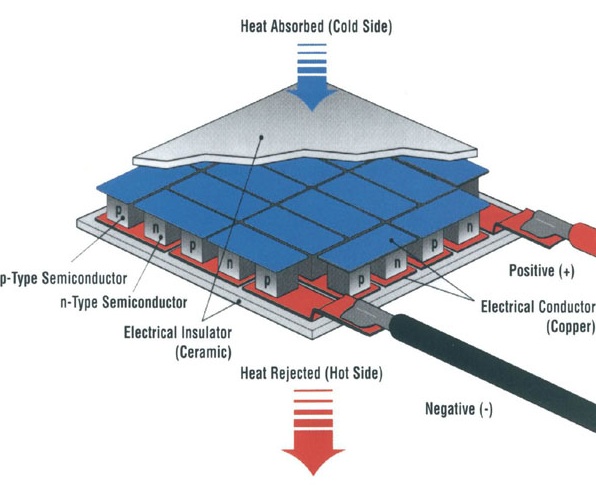 http://topmagneticgenerator.com/images/Thermoelectric-Generator-Diagram.jpg
http://topmagneticgenerator.com/images/Thermoelectric-Generator-Diagram.jpg
Mark Underwood Physics 212 March 2017
As the name might suggest, the thermoelectric effect has applications that always involve either heat energy or electricity. Both the Seebeck and Peltier Effects come into play in different situations.
All thermoelectric applications utilise a device known as a thermocouple. A therocouple is simply one n type and one p type metal connected to a positive and negative lead, so that electricity can flow through them. Any temperature difference will create a voltage difference across the leads, and vice-versa. Generally, many such thermocouples are joined together between an insulating ceramic coating in order to move more energy. This larger configuration, which typically resembles the picture on the right, is also called a thermocouple.
One use of the Seebeck Effect is in thermometers. The cold side of the thermocouple is kept at a constant temperature, and the hot end is used as the temperature probe. Asbestos beads help keep the wire inside the probe insulated. The hotter the probe gets, the greater the temperature differential and therefore the greater the voltage. The voltage produced is used to extrapolate what temperature the probe is at. This kind of thermometer is lauded for its accuracy as well as its ability to measure temperatures quickly without changing the temperature of the thing being measured.
Another use of the Seebeck Effect is in power generation. Large machines that put out waste heat can use a thermoelectric generator to boost efficiency by turning the heat energy into electricity, putting it back into the system. On the right is a picture of a generator designed to recapture heat energy exhausted by diesel vehicles. Another interesting use for a thermoelectric generator is in space travel. When a spacecraft moves too far away from the sun and cannot use solar power any more, thermoelectric generators become a viable way to create electricity.
The most common application of the thermoelectric effect, though, involves cooling rather than heat. By utilising the Peltier Effect, a current can be run through a thermocouple to make it cold. Observe the frost that has formed around the thermocouple pictured at left. So-called Peltier coolers are frequently used in small scale applications, like mini refrigerators or cooling units for electronics. Although the efficiency of Petier coolers is not nearly as good as the coolers in conventional refrigerators, they are completely noiseless, making them perfect for anything that needs to be as quiet as possible.